2015 CHEVROLET CITY EXPRESS sensor
[x] Cancel search: sensorPage 21 of 297
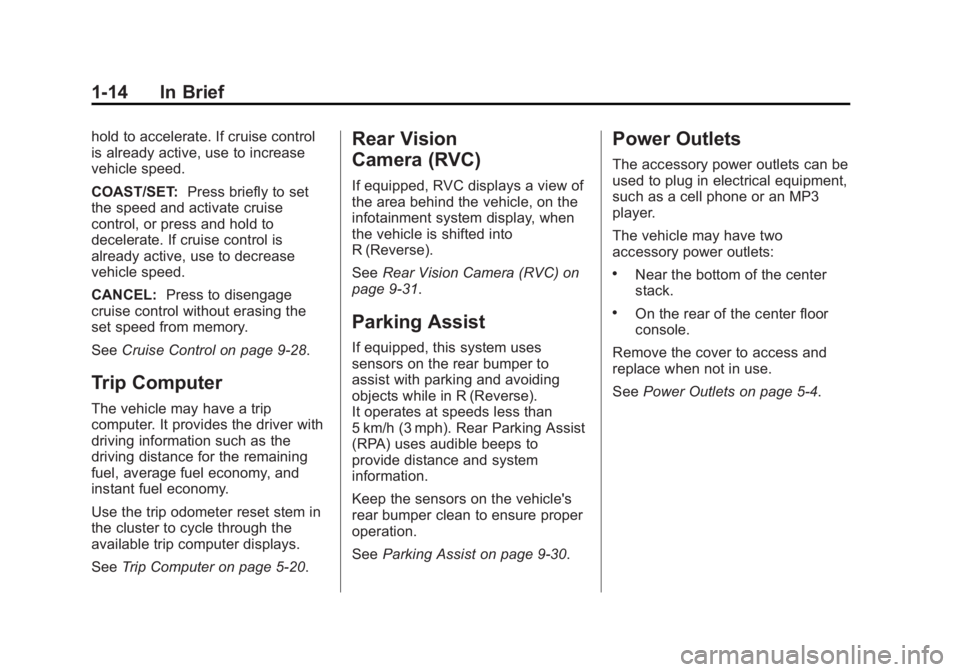
Black plate (14,1)Chevrolet City Express Owner Manual (GMNA-Localizing-U.S./Canada-
7707496) - 2015 - CRC - 11/26/14
1-14 In Brief hold to accelerate. If cruise control
is already active, use to increase
vehicle speed.
COAST/SET: Press briefly to set
the speed and activate cruise
control, or press and hold to
decelerate. If cruise control is
already active, use to decrease
vehicle speed.
CANCEL: Press to disengage
cruise control without erasing the
set speed from memory.
See Cruise Control on page 9-28 .
Trip Computer The vehicle may have a trip
computer. It provides the driver with
driving information such as the
driving distance for the remaining
fuel, average fuel economy, and
instant fuel economy.
Use the trip odometer reset stem in
the cluster to cycle through the
available trip computer displays.
See Trip Computer on page 5-20 .Rear Vision
Camera (RVC) If equipped, RVC displays a view of
the area behind the vehicle, on the
infotainment system display, when
the vehicle is shifted into
R (Reverse).
See Rear Vision Camera (RVC) on
page 9-31 .
Parking Assist If equipped, this system uses
sensors on the rear bumper to
assist with parking and avoiding
objects while in R (Reverse).
It operates at speeds less than
5 km/h (3 mph). Rear Parking Assist
(RPA) uses audible beeps to
provide distance and system
information.
Keep the sensors on the vehicle's
rear bumper clean to ensure proper
operation.
See Parking Assist on page 9-30 .Power Outlets The accessory power outlets can be
used to plug in electrical equipment,
such as a cell phone or an MP3
player.
The vehicle may have two
accessory power outlets: .
Near the bottom of the center
stack. .
On the rear of the center floor
console.
Remove the cover to access and
replace when not in use.
See Power Outlets on page 5-4 .
Page 57 of 297
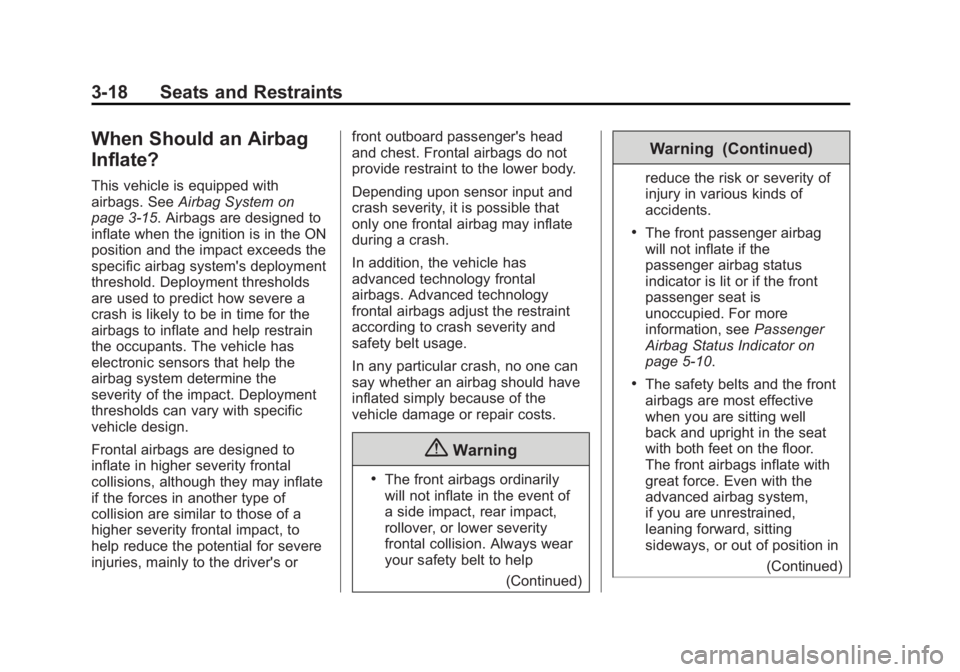
Black plate (18,1)Chevrolet City Express Owner Manual (GMNA-Localizing-U.S./Canada-
7707496) - 2015 - CRC - 11/26/14
3-18 Seats and Restraints
When Should an Airbag
Inflate? This vehicle is equipped with
airbags. See Airbag System on
page 3-15 . Airbags are designed to
inflate when the ignition is in the ON
position and the impact exceeds the
specific airbag system's deployment
threshold. Deployment thresholds
are used to predict how severe a
crash is likely to be in time for the
airbags to inflate and help restrain
the occupants. The vehicle has
electronic sensors that help the
airbag system determine the
severity of the impact. Deployment
thresholds can vary with specific
vehicle design.
Frontal airbags are designed to
inflate in higher severity frontal
collisions, although they may inflate
if the forces in another type of
collision are similar to those of a
higher severity frontal impact, to
help reduce the potential for severe
injuries, mainly to the driver's or front outboard passenger's head
and chest. Frontal airbags do not
provide restraint to the lower body.
Depending upon sensor input and
crash severity, it is possible that
only one frontal airbag may inflate
during a crash.
In addition, the vehicle has
advanced technology frontal
airbags. Advanced technology
frontal airbags adjust the restraint
according to crash severity and
safety belt usage.
In any particular crash, no one can
say whether an airbag should have
inflated simply because of the
vehicle damage or repair costs.
{ Warning .
The front airbags ordinarily
will not inflate in the event of
a side impact, rear impact,
rollover, or lower severity
frontal collision. Always wear
your safety belt to help
(Continued) Warning (Continued) reduce the risk or severity of
injury in various kinds of
accidents. .
The front passenger airbag
will not inflate if the
passenger airbag status
indicator is lit or if the front
passenger seat is
unoccupied. For more
information, see Passenger
Airbag Status Indicator on
page 5-10 . .
The safety belts and the front
airbags are most effective
when you are sitting well
back and upright in the seat
with both feet on the floor.
The front airbags inflate with
great force. Even with the
advanced airbag system,
if you are unrestrained,
leaning forward, sitting
sideways, or out of position in
(Continued)
Page 58 of 297
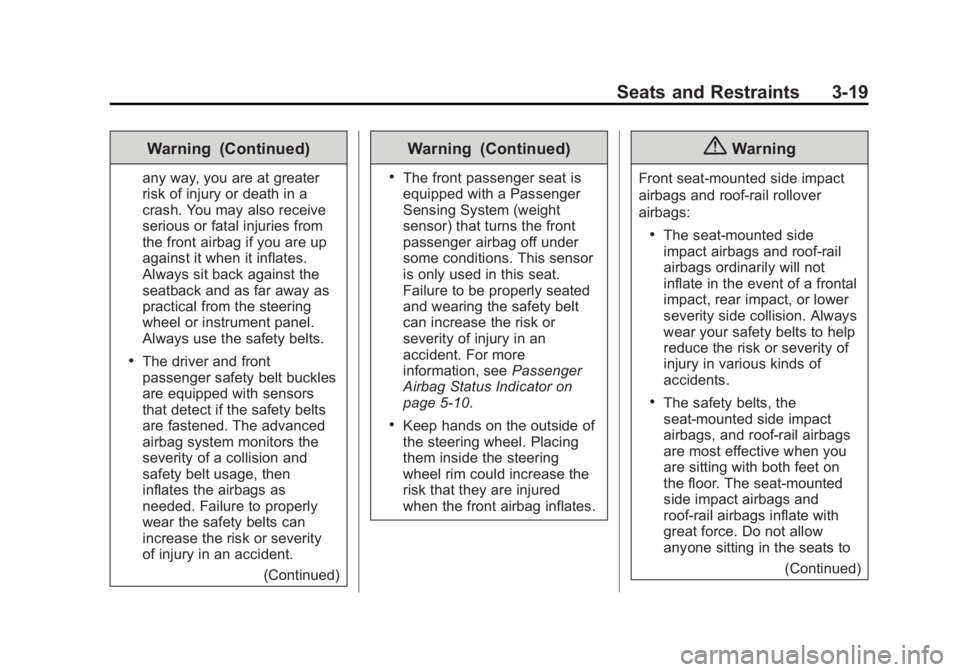
Black plate (19,1)Chevrolet City Express Owner Manual (GMNA-Localizing-U.S./Canada-
7707496) - 2015 - CRC - 11/26/14
Seats and Restraints 3-19Warning (Continued) any way, you are at greater
risk of injury or death in a
crash. You may also receive
serious or fatal injuries from
the front airbag if you are up
against it when it inflates.
Always sit back against the
seatback and as far away as
practical from the steering
wheel or instrument panel.
Always use the safety belts. .
The driver and front
passenger safety belt buckles
are equipped with sensors
that detect if the safety belts
are fastened. The advanced
airbag system monitors the
severity of a collision and
safety belt usage, then
inflates the airbags as
needed. Failure to properly
wear the safety belts can
increase the risk or severity
of injury in an accident.
(Continued) Warning (Continued) .
The front passenger seat is
equipped with a Passenger
Sensing System (weight
sensor) that turns the front
passenger airbag off under
some conditions. This sensor
is only used in this seat.
Failure to be properly seated
and wearing the safety belt
can increase the risk or
severity of injury in an
accident. For more
information, see Passenger
Airbag Status Indicator on
page 5-10 . .
Keep hands on the outside of
the steering wheel. Placing
them inside the steering
wheel rim could increase the
risk that they are injured
when the front airbag inflates.{ WarningFront seat-mounted side impact
airbags and roof-rail rollover
airbags: .
The seat-mounted side
impact airbags and roof-rail
airbags ordinarily will not
inflate in the event of a frontal
impact, rear impact, or lower
severity side collision. Always
wear your safety belts to help
reduce the risk or severity of
injury in various kinds of
accidents. .
The safety belts, the
seat-mounted side impact
airbags, and roof-rail airbags
are most effective when you
are sitting with both feet on
the floor. The seat-mounted
side impact airbags and
roof-rail airbags inflate with
great force. Do not allow
anyone sitting in the seats to
(Continued)
Page 61 of 297
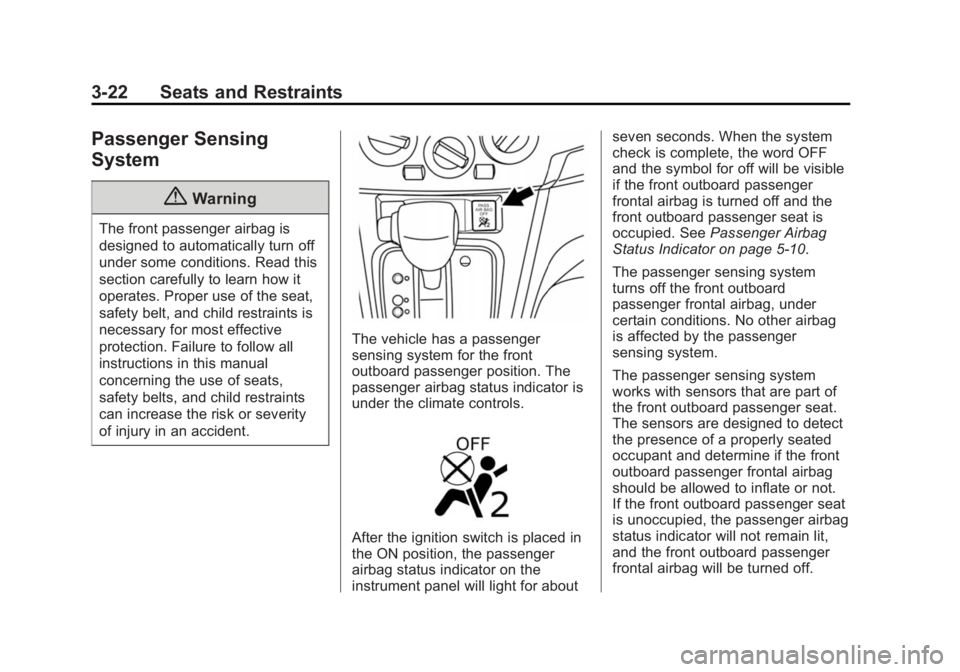
Black plate (22,1)Chevrolet City Express Owner Manual (GMNA-Localizing-U.S./Canada-
7707496) - 2015 - CRC - 11/26/14
3-22 Seats and Restraints
Passenger Sensing
System
{ WarningThe front passenger airbag is
designed to automatically turn off
under some conditions. Read this
section carefully to learn how it
operates. Proper use of the seat,
safety belt, and child restraints is
necessary for most effective
protection. Failure to follow all
instructions in this manual
concerning the use of seats,
safety belts, and child restraints
can increase the risk or severity
of injury in an accident. The vehicle has a passenger
sensing system for the front
outboard passenger position. The
passenger airbag status indicator is
under the climate controls.
After the ignition switch is placed in
the ON position, the passenger
airbag status indicator on the
instrument panel will light for about seven seconds. When the system
check is complete, the word OFF
and the symbol for off will be visible
if the front outboard passenger
frontal airbag is turned off and the
front outboard passenger seat is
occupied. See Passenger Airbag
Status Indicator on page 5-10 .
The passenger sensing system
turns off the front outboard
passenger frontal airbag, under
certain conditions. No other airbag
is affected by the passenger
sensing system.
The passenger sensing system
works with sensors that are part of
the front outboard passenger seat.
The sensors are designed to detect
the presence of a properly seated
occupant and determine if the front
outboard passenger frontal airbag
should be allowed to inflate or not.
If the front outboard passenger seat
is unoccupied, the passenger airbag
status indicator will not remain lit,
and the front outboard passenger
frontal airbag will be turned off.
Page 66 of 297
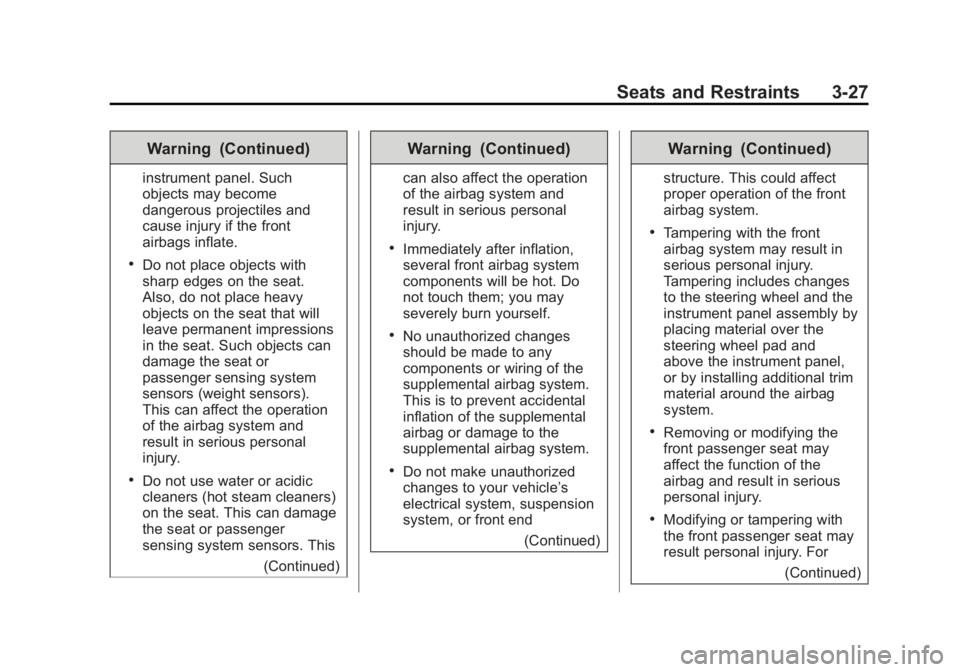
Black plate (27,1)Chevrolet City Express Owner Manual (GMNA-Localizing-U.S./Canada-
7707496) - 2015 - CRC - 11/26/14
Seats and Restraints 3-27Warning (Continued) instrument panel. Such
objects may become
dangerous projectiles and
cause injury if the front
airbags inflate. .
Do not place objects with
sharp edges on the seat.
Also, do not place heavy
objects on the seat that will
leave permanent impressions
in the seat. Such objects can
damage the seat or
passenger sensing system
sensors (weight sensors).
This can affect the operation
of the airbag system and
result in serious personal
injury. .
Do not use water or acidic
cleaners (hot steam cleaners)
on the seat. This can damage
the seat or passenger
sensing system sensors. This
(Continued) Warning (Continued) can also affect the operation
of the airbag system and
result in serious personal
injury. .
Immediately after inflation,
several front airbag system
components will be hot. Do
not touch them; you may
severely burn yourself. .
No unauthorized changes
should be made to any
components or wiring of the
supplemental airbag system.
This is to prevent accidental
inflation of the supplemental
airbag or damage to the
supplemental airbag system. .
Do not make unauthorized
changes to your vehicle ’ s
electrical system, suspension
system, or front end
(Continued) Warning (Continued) structure. This could affect
proper operation of the front
airbag system. .
Tampering with the front
airbag system may result in
serious personal injury.
Tampering includes changes
to the steering wheel and the
instrument panel assembly by
placing material over the
steering wheel pad and
above the instrument panel,
or by installing additional trim
material around the airbag
system. .
Removing or modifying the
front passenger seat may
affect the function of the
airbag and result in serious
personal injury. .
Modifying or tampering with
the front passenger seat may
result personal injury. For
(Continued)
Page 67 of 297
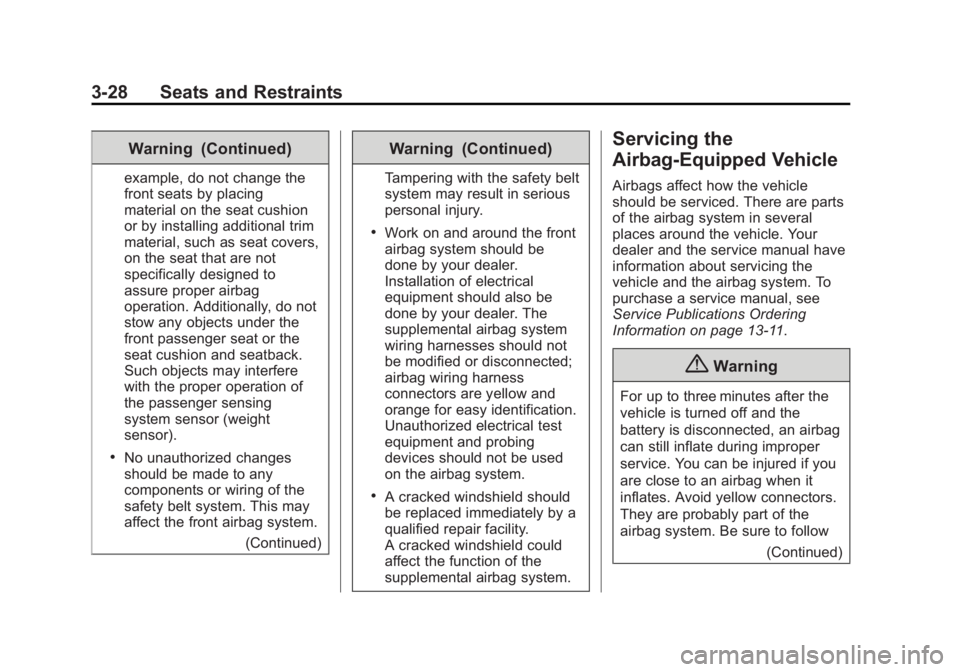
Black plate (28,1)Chevrolet City Express Owner Manual (GMNA-Localizing-U.S./Canada-
7707496) - 2015 - CRC - 11/26/14
3-28 Seats and Restraints Warning (Continued) example, do not change the
front seats by placing
material on the seat cushion
or by installing additional trim
material, such as seat covers,
on the seat that are not
specifically designed to
assure proper airbag
operation. Additionally, do not
stow any objects under the
front passenger seat or the
seat cushion and seatback.
Such objects may interfere
with the proper operation of
the passenger sensing
system sensor (weight
sensor). .
No unauthorized changes
should be made to any
components or wiring of the
safety belt system. This may
affect the front airbag system.
(Continued) Warning (Continued) Tampering with the safety belt
system may result in serious
personal injury. .
Work on and around the front
airbag system should be
done by your dealer.
Installation of electrical
equipment should also be
done by your dealer. The
supplemental airbag system
wiring harnesses should not
be modified or disconnected;
airbag wiring harness
connectors are yellow and
orange for easy identification.
Unauthorized electrical test
equipment and probing
devices should not be used
on the airbag system. .
A cracked windshield should
be replaced immediately by a
qualified repair facility.
A cracked windshield could
affect the function of the
supplemental airbag system. Servicing the
Airbag-Equipped Vehicle Airbags affect how the vehicle
should be serviced. There are parts
of the airbag system in several
places around the vehicle. Your
dealer and the service manual have
information about servicing the
vehicle and the airbag system. To
purchase a service manual, see
Service Publications Ordering
Information on page 13-11 .
{ WarningFor up to three minutes after the
vehicle is turned off and the
battery is disconnected, an airbag
can still inflate during improper
service. You can be injured if you
are close to an airbag when it
inflates. Avoid yellow connectors.
They are probably part of the
airbag system. Be sure to follow
(Continued)
Page 68 of 297
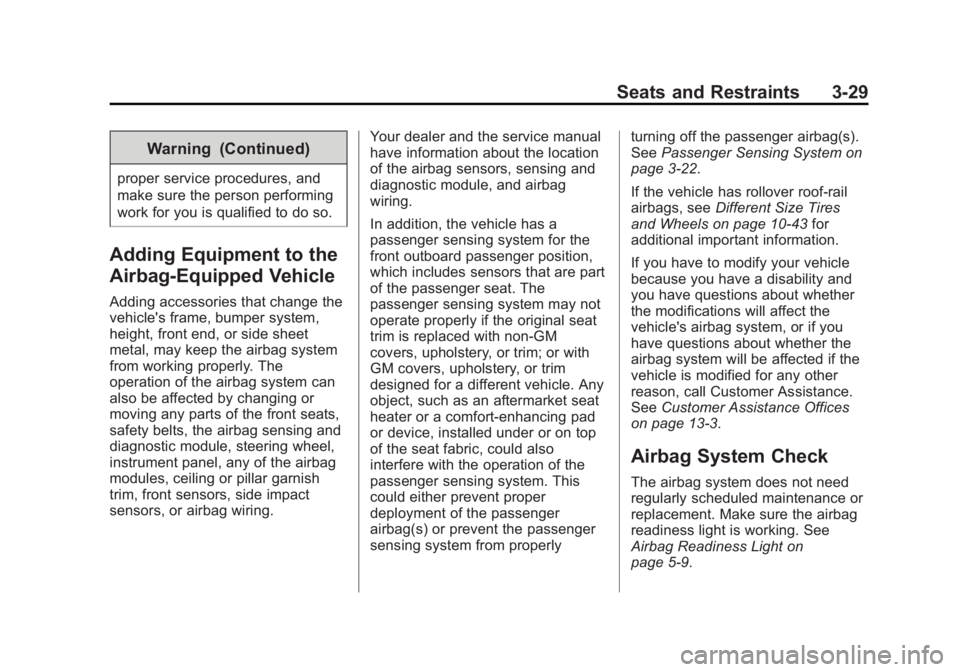
Black plate (29,1)Chevrolet City Express Owner Manual (GMNA-Localizing-U.S./Canada-
7707496) - 2015 - CRC - 11/26/14
Seats and Restraints 3-29Warning (Continued)proper service procedures, and
make sure the person performing
work for you is qualified to do so.
Adding Equipment to the
Airbag-Equipped Vehicle Adding accessories that change the
vehicle's frame, bumper system,
height, front end, or side sheet
metal, may keep the airbag system
from working properly. The
operation of the airbag system can
also be affected by changing or
moving any parts of the front seats,
safety belts, the airbag sensing and
diagnostic module, steering wheel,
instrument panel, any of the airbag
modules, ceiling or pillar garnish
trim, front sensors, side impact
sensors, or airbag wiring. Your dealer and the service manual
have information about the location
of the airbag sensors, sensing and
diagnostic module, and airbag
wiring.
In addition, the vehicle has a
passenger sensing system for the
front outboard passenger position,
which includes sensors that are part
of the passenger seat. The
passenger sensing system may not
operate properly if the original seat
trim is replaced with non-GM
covers, upholstery, or trim; or with
GM covers, upholstery, or trim
designed for a different vehicle. Any
object, such as an aftermarket seat
heater or a comfort-enhancing pad
or device, installed under or on top
of the seat fabric, could also
interfere with the operation of the
passenger sensing system. This
could either prevent proper
deployment of the passenger
airbag(s) or prevent the passenger
sensing system from properly turning off the passenger airbag(s).
See Passenger Sensing System on
page 3-22 .
If the vehicle has rollover roof-rail
airbags, see Different Size Tires
and Wheels on page 10-43 for
additional important information.
If you have to modify your vehicle
because you have a disability and
you have questions about whether
the modifications will affect the
vehicle's airbag system, or if you
have questions about whether the
airbag system will be affected if the
vehicle is modified for any other
reason, call Customer Assistance.
See Customer Assistance Offices
on page 13-3 .
Airbag System Check The airbag system does not need
regularly scheduled maintenance or
replacement. Make sure the airbag
readiness light is working. See
Airbag Readiness Light on
page 5-9 .
Page 96 of 297

Black plate (9,1)Chevrolet City Express Owner Manual (GMNA-Localizing-U.S./Canada-
7707496) - 2015 - CRC - 11/26/14
Instruments and Controls 5-9Here are four things that some
owners ask about. None of these
show a problem with the fuel gauge: .
At the service station, the gas
pump shuts off before the gauge
reads full. .
It takes a little more or less fuel
to fill up than the gauge
indicated. For example, the
gauge may have indicated the
tank was half full, but it actually
took a little more or less than
half the tank's capacity to fill
the tank. .
The indicator moves a little when
turning a corner or speeding up. .
The gauge goes back to empty
when the ignition is turned off. Safety Belt Reminders
The light and chime remind you to
fasten your safety belts. The light
illuminates when the ignition is
placed in ON or START and remains
illuminated until the driver ’ s safety
belt is fastened. At the same time,
the chime sounds for about
six seconds unless the driver ’ s
safety belt is securely fastened.
The safety belt warning light may
also illuminate if the front
passenger ’ s safety belt is not
fastened when the front passenger
seat is occupied. For
seven seconds after the ignition
switch is placed in ON, the system
does not activate the warning light
for the front passenger. { WarningIf the safety belt warning light
stays on continuously while the
ignition is turned ON with all
doors closed and all safety belts
fastened, it may indicate a
malfunction in the system. Have
the system checked by your
dealer.
See Safety Belts on page 3-8 .
Airbag Readiness Light This light shows if there is an
electrical problem with the airbag
system. The system check includes
the airbag sensor(s), passenger
sensing system, the pretensioners,
the airbag modules, the wiring, and
the crash sensing and diagnostic
module. For more information on the
airbag system, see Airbag System
on page 3-15 .